Manuscript accepted on :11-03-2021
Published online on: 20-03-2021
Plagiarism Check: Yes
Reviewed by: Dr. Daniela Serban
Second Review by: Dr. Jyothsna Rao
Final Approval by: Dr. Francesca Gorini
Meenakshi Sreeram* and Mona. A. Mundada
and Mona. A. Mundada
Department of General Human Physiology and Biochemistry, MGV’s KBH Dental College and Hospital, Nasik, Maharashtra University of Health Sciences, Maharashtra, India- 422 003.
Corresponding Author E-mail: s.meenakshi492@gmail.com
DOI : https://dx.doi.org/10.13005/bpj/2098
Abstract
Objectives: Various studies across the globe have emphasized the importance of monitoring stress levels among students pursuing professional courses, especially medical and dental students. The pandemic caused by the novel Corona virus affected the lives of people and economies of almost all nations in a manner no one could have ever fathomed. Unexpected and unprecedented changes have occurred in the way we work, study, interact, travel and many aspects of the way we humans lead our lives.The period of lockdown was a difficult period for everyone, more so for the youth, as they were forced to remain indoors, now no longer being able to physically interact with their friends,go to college, visit malls, socialize, pursue pass-times and hobbies or generally have a life that the younger generation is used to.Academic activities initially came to a standstill before shifting to online mode which was new to both, teachers and students. The objective of the current questionnaire-based study was to find out the perceived stress levels during the COVID-19 lockdown among the students and how capable they think they are to cope with these testing times.
Methods: This survey was undertaken among the students from first to final year of a dental college in Nasik, Maharashtra in the first phase of lockdown in India from 22 Mar 2020 to 14 April 2020. A pretested self-administered questionnaire using Google forms was used for the data collection after getting approval from the Institutional Ethical Committee.
Results and Conclusions:Students from all the four years reported being stressed and academic factors were one of the most important stressors. During the lockdown, portion completion, delay in academic activities, uncertainties of the disease and the impending exams were the main causes of anxiety and stress. Continuous student engagement during the period and the availability of a staff to discuss and talk out a problem helped in a big way.It is suggested that mental health of college students should be monitored during such unusual circumstances as the pandemic. The introduction of stress management education into the curriculum could prove useful to the students to help them deal with any such situation in the future.
Keywords
COVID-19; Lockdown; Mental health; Novel Corona Virus; Pandemic; Stress
Download this article as:| Copy the following to cite this article: Sreeram M, Mundada M. A. Survey to Assess Perceived Causes of Stress, Its Manifestations and Coping Strategies Among Dental College Students in Maharashtra During COVID-19 Lockdown. Biomed Pharmacol J 2021;14(1) |
| Copy the following to cite this URL: Sreeram M, Mundada M. A. Survey to Assess Perceived Causes of Stress, Its Manifestations and Coping Strategies Among Dental College Students in Maharashtra During COVID-19 Lockdown. Biomed Pharmacol J 2021;14(1). Available from: https://bit.ly/3vQkiQH |
Introduction
College life is a very important part of the life of every student and something every student looks forward to from his/ her school days. Both, parents and their wards, go through a lot of hard work and sacrifice to get the student admitted into a course and college of their choice. Besides providing the student a degree to set forth into the world, it also teaches him the skills needed to survive in the world, the ability to face the challenges, to meet mentors who would give a new direction to life, to make lasting friendships, maybe meet future life-partners, to discover aspects about one-self and many more. Many find a transition in themselves when they set out of the cocooned atmosphere of home and school into the college life.But this phase may also bring forth many types of stress in the lives of students as they try to balance a demanding curriculum and peer pressure.(Lakyntiew Pariat, et al, 2014).
The concept of stress was first introduced in 1936, by Hans Seyle, the late Hungarian-Canadian endocrinologist, who is considered the “father of stress research”. The word stress was used to describe both an agent and its consequences. Seyle called stress as “the salt of life” but it has now become synonymous with everything that is perceived as bad though stress can also be experienced positively. Later Seyle used the word “stressor” for the perceived threat and “stress” as the reaction of the organism.Stress manifests itself in different ways varying from mild irritation to severe problems that might result in a real breakdown of health. For a layman almost any event or situation between these extremes may be described as stressful. All individuals vary in their capacities to perform, adapt and accommodate when they face stress. But ultimately everyone a breaking point, and when stress becomes difficult to manage, performance suffers and can cause both physical and mental harm. Stress is a natural part of the biological response mechanism of the body. It does not just mean being nervous or anxious, having too much of work or too much to study and it need not always be damaging and neither can it be completely avoided as it. (Sheena Johnson, et al, 2005)In our lives, stress can be physical (due to disease/ illness), emotional (grief due to loss of loved one, divorce, etc.), or psychological (fear due to war, assault, accident, etc.)(Bruce McEwen, et al, 2006)
Academic stress could be a form of “un-favorable stress” as it can affect the ability to learn and is often associated negatively with a student’s academic performance. It is a common problem faced by the students and their perception and the way they handle itreflects on their day to day affairs including academics. It is well accepted that the stress is an indispensable part of the demanding nature of a student’s life and a lot can be achieved if the student learns to cope and achieve a balance. (Agolla, J. E, et al. 2009)High levels of stress during medical school can result in burnout syndrome, which is characterized by a state of physical and mental exhaustion connected to work or activities of care. Chronic stress can bring about the onset of many diseases. It is important to identify and develop adaptive coping mechanisms in students to prevent them from developing maladaptive strategies such as alcohol consumption, isolation, anxiety, depression, etc. (ÍcaroJ.S.Ribeiro,et al. 2018)A certain level of stress is needed to push students towards optimum performance, but it needs to be managed efficiently as inadequate resources to cope with the stress can have distressing consequences both for the student as well as the institution. (Reddy K.J, et al, 2018)
Reports indicate that students experience high academic stress at predictable times in each semester, and the culprits are preparing for and taking exams, class ranking competition and mastering huge amount of syllabus in a comparatively very small amount of time(Rawson, H. E., et al. 1999; Linn, B.S, et al. 1984; Winter, M. G., et al. 2000) concluded that increased stress during the first year of college can predict lower level of overall adjustment and can make the students more susceptible to many social and psychological problems, thus leading to a lower grade point average (GPA) in the final year Williamson et al reported that when the youth are anxious and depressed, they are likely to experience stressful life events which in turn lead to low performance in academics.(Williamson, D. E., et al., 2005)Thus, it is very important for staff to be on the lookout for warning signs in the students and create an atmosphere where in the student feels free and comfortable to discuss his/her problems or have a counselor on campus to cater to the students’ needs.
Coronavirus disease or COVID-19 is the name given to an infectious disease which was firstdetected in Wuhan, China in December 2019. As the number of patients rose dramatically in China and many other countries began reporting similar cases, WHO declared the outbreak a Public Health Emergency of International Concern(PHEIC) on 30 January 2020. By 11 Mar 2020, the number of cases outside China had increased 13- fold as the disease spread rapidly in many countries across the world. The official number of cases was more than 118,000 cases in 114 countries with more than 4,000 people dead and thousands more fighting for their lives forcing the WHO to declare COVID -19 a pandemic. (https://www.who.int) At that time, the pandemic was just beginning to rear its head in India with 60 confirmed cases and a single death reported. (https://www.statista.com/statistics) COVID-19 is caused by a coronavirus which has been named the novel corona virus (nCoV) or SARS-CoV-2 virus. It belongs to a large family of viruses that are common in people and also in many different species of animals, including camels, cattle, cats, and bats. Like MERS-CoV and SARS-CoV, it has its origins in bats and can infect humans and then spread between people. (Meenakshi Sreeram, 2020)
On 16 Mar 2020, WHO issued an advisory to all countries to test every suspected case of COVID-19 and to isolate not just the patient but also all those that they have been in close contact with up to 2 days before they developed symptoms. Testing, isolation and care were the three measures emphasized by the organization. (https:// www. who. int/emergencies/diseases/novel-coronavirus-2019)Governments and administrations took refuge of classical communal health measures to curb this epidemic, the primary goal of which was to prevent the person-to-person spread of disease by keeping people apart to interrupt transmission. The available tools to implement this are isolation and quarantine, social distancing and community containment/Lockdown. The first step taken by the government was to close the schools and colleges of the country and ask students to vacate the hostels. In response to the guidelines given, our college declared the closure of teaching and clinical activities from 17th Mar 2020 until further notice. Due to this, many students hurriedly travelled to their hometowns and their home states to be in the safety and comfort of their homes.The Indian government was one of the first countries in the world to impose a lock down of three weeks from 25th March 2020, all over the country and bring all activities to a grinding halt. What looked like a short unexpected holiday for students suddenly seemed like a long phase of uncertainty. Students were unsure about how their academic year would progress, how would portion be completed and when would the pending college exams would be conducted and many such related issues.
Concerned about the students’ well-being and mental health, the authors designed a questionnaire to get to know about the perceived stress, it’s effects and manifestations in the students, coping mechanisms during the lockdown and what they feel about the sudden transition to online teaching. At that point in time, Nasik was relatively unaffected by the disease but our students belong to various parts of Maharashtra and outside the state too. Maharashtra has been one of the worst affected states in the country with regard to the number of active cases and mortality due to COVID-19.
Material and Methods
The study population are the students from first to final year of a dental college in Nasik, Maharashtra surveyed when the second phase of lock down in India began from 15th April 2020. A pretested self-administered question naire using Google documents was used for the data collection after getting approval from the Institutional Ethical Committee. The survey document was sent out on 20 Apr 2020 and responses were accepted till 03 May 2020. Students were contacted using their respective class Whats App group. All participants voluntarily gave their informed consent to participate in the study after being informed about the purpose of the study. Students had to log in using their registered mail id and it was restricted to one response per student.Ease of access to online link resulted in better response rate and most of the data was collected in the first week of administering the questionnaire. The approximate time needed by each student to respond to the questionnaire was 20 minutes.The college has an intake of 100 students per year and in all 361 of the 400 students responded. Some of the students reside in remote areas where internet connectivity is an issue which resulted in some responses not being recorded. All data has been expressed in percentage.
Results
A total of 361 students responded to the questionnaire which is 90% of the students currently pursuing the course at the institute, 74.5 % of which were females.On a scale from 1 to 10, 2.5% rated stress levels as 1, 21% graded the stress level as 5, 19.1% graded it as 6, 19.1% graded it as 7 and 4.2% rated their stress levels at the maximum of 10. (Graph 1) 88% of the students felt that issues related to studies was among the top causes of stress during a routine year while issues related to friends, family, problems with staff, financial issues and health were among the other main causes.(Graph 2)Research has demonstrated that dental students experience considerable stress during their training and that dental students are more anxious than the general population. This high anxiety is worrying in its own right, but it has also been suggested that dental students’ stress negatively impacts their physical and mental health.(Piazza-Waggoner CA, et al., 2003).
 |
Graph 1: bar graph showing student responses of how stressed they feel on a daily basis. |
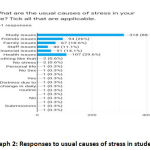 |
Graph 2: Responses to usual causes of stress in students. |
When the students were asked not to come to college, only 7.8% reported as being thrilled at the prospect, 11.9% were distressed about completion of syllabus, 18.3% were happy about getting to go home, 20.2% were apprehensive about how and when they would be able to fill exam forms while 33.5% were frustrated at there being no clarity about how long this would last.(GRAPH 3) This could be because of two reasons: a) Students in professional colleges are pretty much focused on their academics b) The college is indeed a wonderful place for the students to learn and thrive.
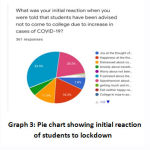 |
Graph 3: Pie chart showing initial reaction of students to lock down. |
89.8% of the students reported being worried about academics when lockdown was announced while only 68.4% reported that they tried to revise the subjects on their own. 61.5% of the students said that they needed to interact with their staff to clear their doubts and an additional 31.9% said they needed a teacher’s help sometimes.(GRAPH 4) One very reassuring answer is that 50.7 % reported that staff members were always available to help them out while 45.4% reported that some of the staff was available.(GRAPH 5) This reflects very positively on the institute that the staff is approachable and students feel comfortable interacting with them even when distance separates them.41.6% of the students said that one thing that they missed the most was meeting their friends and 32.7% missed coming to college. This again bodes very well for the institute as it indicates that the students perceive it as a happy place where they enjoy spending time.
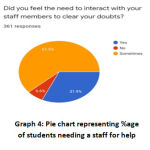 |
Graph 4: Pie chart representing %age of students needing a staff for help. |
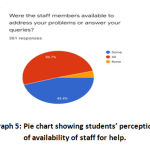 |
Graph 5: Pie chart showing students’ perception of availability of staff for help. |
As expected, 66.5% said that they were really stressed about COVID-19 scenario while 29.1% admitted being some what stressed.(GRAPH 6) Each student experienced manifestation of stress during the lock down in different ways like sleeplessness, anxiety, headache, frustration, irritability, inability to concentrate, etc. 221 of the 361 surveyed said that the safety of self and family members was their prime concern. Change in sleep pattern (60.4%) and change in eating habits (47.1%) were the prime psychological changes while 23.3% reported being hypervigilant and obsessed with hand washing. Change in appetite and headache were reported to be the chief physical manifestations of stress while 35.7 % of those surveyed did not report any effects. Difficulty in concentrating and limited attention span (48.8%) was the leading cognitive effect of stress reported in the students. Another reassuring fact was that 61.5% of the students said they did not find any social changes in their behavior. The quality family time that the lock down provided and the comfort of being at home and sharing responsibilities and house work would have resulted in stronger bonding with family members. A vast majority reported listening to music (73.7%) as a favorite form of relieving stress while talking to friends (54.6%), talking to elders (48.8%), sleeping (45.8%) and pursuing their hobbies (39.1%) were the other preferences. Contrary to popular belief, only 29.6% said they use social media to relieve stress.
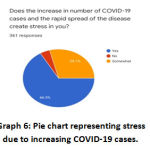 |
Graph 6: Pie chart representing stress due to increasing COVID-19 cases. |
68.4% reported trying to gather all information about COVID-19 in this period. (GRAPH 7) During the lock down there was a spurt of online hobby classes and other academic courses. 82.5% reported having developed a new skill or hobby during the lock down though only 36.6% reported pursuing any professional enhancement or COVID-19 related courses. (GRAPH 8) Only 30.7% replied in the affirmative when asked if they were motivated enough to study and prepare themselves for the exams while 54.6% said they could do it to some extent. (GRAPH 9)39.9% said online teaching cannot replace classroom teaching, 41.6% said it could to some extent and only 7.5 % felt that online teaching would be the way forward. (GRAPH 10)
 |
Graph 7: Pie chart depicting how many students gathered information on COVID-19. |
 |
Graph 8: Pie chart depicting students who did professional enhancement courses. |
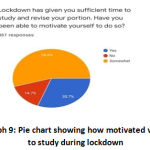 |
Graph 9: Pie chart showing how motivated were to study during lock down. |
 |
Graph 10: Pie chart showing student responses to whether online teaching can replace classroom teaching. |
The last question was about how capable a student feels about being able to handle stress on his own on a scale of 1 to 10. 23.5% of the students rated themselves at 5 or below. It is good to know that 39.1% of our students put themselves at 8 and above on this scale. (GRAPH 11).
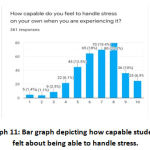 |
Graph 11: Bar graph depicting how capable students felt about being able to handle stress. |
Discussion
Anxiety, fear, and worry are some of the psychological effects of public health emergencies on college students.(Mei S.L., et al, 2011)Our survey found similar manifestations in our college students. 24.9% of college students experienced anxiety because of the COVID-19 outbreak in a survey conducted in China.(Wenjun Cao, et al, 2020)In our survey more than 65% of those surveyed reported being really anxious about the COVID-19 situation. Students were worried about portion completion and exams during the lock down, which have been reported in other studies as well.College students’ anxiety about COVID-19 may have been related to the effect of the virus and the resulting scenario on their studies. (Cornine A, 2020)
An online Facebook survey conducted in Taiwan found 55.8% of the participants with sleep disturbance and 10.8% having suicidal thoughts which were because of the COVID-19 pandemic. Some of the causes which were reported as being significantly associated with sleep disturbance were increased worry about COVID-19, more severe impact of COVID-19 on social interaction, lower perceived social support, more severe academic/occupational interference due to COVID-19, lower COVID-19-specified support, and poorer self-reported physical health. (Dian-Jeng Li, et al, 2020).
Studies have shown the negative impact of stress on the mental and physical health of the students. The findings in regard to dental students’ coping strategies are enlightening. First, students generally reported using more effective and healthy coping (e.g., planning, positive reframing) than poor coping (e.g., denial, substance use)(Piazza-Wag goner CA, et al., 2003)
The students’ anxiety may have been caused by the gradually increasing physical distances between people due to the lock down. Anxiety disorders are more likely to occur and worsen in the absence of interpersonal communication(Xiao C., 2020)
Living with parents was a favorable factor which helped our students to cope better. Psychological pressure during the epidemics can be eased if social support is availableand it also changes the attitude of the person regarding social support and help-seeking methods. (Wenjun Cao, et al, 2020).
Conclusions
Methods of guiding students to effectively and appropriately regulate their emotions during public health emergencies and avoid losses caused by crisis events have become an important issue faced by colleges and universities.
Although the aim of this study wasn’t to demonstrate the benefits of effective stress management, we believe that this kind of training incorporated in the curriculum could reduce the overall anxiety, improve academic performance and technical skills, help students express and develop positive coping strategies and ultimately help in development of a more confident individual. It is extremely important to identify the stress provoking factors, whether academic or otherwise, which would be the first step towards advocating and implementing policy changes like modifications in curriculum and examination pattern, student support mechanisms, etc.These strategies would help to alleviate the stressors, thus enhancing the coping skills of a student. (Harikiran AG, et al, 2012)The mental health of college students is significantly affected when faced with public health emergencies, and they require attention, help, and support of the society, families, friends and college authorities. It is suggested that the government and colleges should collaborate to tackle this problem in order to provide good-quality, timely crisis- oriented psychological services to college students.
Acknowledgement
The authors would like to thank all the students who participated whole-heartedly in this survey.
Conflict of interest
The authors declare no conflict of interest.
Funding sources
No funding has been received from any organization to conduct this survey.
References
- Stress Levels of College Students: Interrelationship between Stressors and Coping Strategies. Ms. LakyntiewPariat, MsAngelyneRynjah and Ms Joplin, M G Kharjana. IOSR Journal of Humanities and Social Science (IOSR-JHSS), 2014; 19 (8), Ver. III: 40-46
CrossRef - Sheena Johnson, Cooper C., Cartwright S., Ian Donald Paul Taylor., Millet C. The experience of work-related stress across occupations, Journal of Managerial Psychology, 2005;20 (2):178-187.
CrossRef - Bruce McEwen,Robert Sapolsky. Stress and your health. The Journal of Clinical Endocrinology and Metabolism,2006; 91(2)1:E2.
CrossRef - Agolla, J. E. and Ongori, H. An Assessment of Academic Stress among Undergraduate students: The Case of University of Botswana. Educational Research and Review,2009; 4 (2): 63- 70.
- ÍcaroJ.S.Ribeiro, RafaelPereira, IvnaV.Freire, Bruno G.de Oliveira, Cezar A.Casotti, Eduardo N.Boery. Stress and Quality of Life Among University Students: A Systematic Literature Review. Health Professions Education, 2018; 4( 2):70-77
CrossRef - Reddy K.J, Menon K.R, Thattil A. Academic stress and its sources Among University Students. Biomed Pharmacol J 2018; 11 (1)
CrossRef - Rawson, H. E., Bloomer, K., and Kendall, A. (1999). Stress, anxiety, depression, and physical illness in college students. The Journal of Genetic Psychology, 155(3): 321-330.
CrossRef - Linn, B.S. and Zeppa R. (1984) Stress in junior medical stunts relationship to personality and performance. Journals of medical education, 1984; 59:7-12
CrossRef - Winter, M. G. and Yaffe, M. First-year students’ adjustment to university life as a function of relationship with parents. Journal of Adolescent Research,2000; 5(1): 9 -37.
CrossRef - Williamson, D. E., Birmaher, B., Ryan, N. D., and Dahl, R. E. Stressful life events in anxious and depressed children. Journal of Child and Adolescent Psychopharmacology, 2005; 15 (4): 571–580.
CrossRef - https://www.who.int/dg/speeches/detail/who-director-general-s-opening-remarks-at-the-media-briefing-on-covid-19—11-march-2020 Accessed on 18 Aug 2020.
- https://www.statista.com/statistics/1104054/india-coronavirus-covid-19-daily-confirmed-recovered-death-cases/ accessed on 18 Aug 2020.
- Meenakshi Sreeram. COVID- 19: What we know so far and what are the implications for India? IOSR Journal of Dental and Medical Sciences (IOSR-JDMS)2020; 19(4) Ser.6: 34-41
- https://www.who.int/emergencies/diseases/novel-coronavirus-2019/events-as-they-happen Accessed on 18 Aug 2020.
- Piazza-Waggoner CA, Cohen LL, Kohli K, Taylor BK. Stress Management for Dental Students Performing Their First Pediatric Restorative Procedure.J Dent Educ, 2003;67(5):542-548
CrossRef - Mei S.L., Yu J.X., He B.W., Li J.Y. Psychological investigation of university students in a university in Jilin province. Med Soc (Berkeley) 2011; 24(05):84–86.
- Wenjun Cao, Ziwei Fang, Guoqiang Hou, Mei Han, Xinrong Xu,Jiaxin Dong, and Jianzhong Zheng.The psychological impact of the COVID-19 epidemic on college students in China. Psychiatry Res., 2020; 287: 112934.
CrossRef - Cornine A. Reducing nursing student anxiety in the clinical setting: an integrative review. Nurs Educ Perspect., 2020;41(4):229-234
CrossRef - Dian-Jeng Li, Nai-Ying Ko, Yi-Lung Chen, Peng-Wei Wang, Yu-Ping Chang, Cheng-Fang Yen, and Wei-Hsin LuCOVID-19-Related Factors Associated with Sleep Disturbance and Suicidal Thoughts among the Taiwanese Public: A Facebook Survey. Int J Environ Res Public Health 2020; 17(12): 4479.
CrossRef - Xiao C. A novel approach of consultation on 2019 novel coronavirus (COVID-19)-Related psychological and mental problems: structured letter therapy. Psychiatry Investig. 2020;17(2):175–176.
CrossRef - Wenjun Cao, Ziwei Fang, Guoqiang Hou, Mei Han, Xinrong Xu,Jiaxin Dong, and Jianzhong Zheng.The psychological impact of the COVID-19 epidemic on college students in China. Psychiatry Res. 2020; 287: 112934.
CrossRef - Harikiran AG, Srinagesh J, Nagesh KS, Sajudeen N. Perceived sources of stress amongst final year dental under graduate students in a dental teaching institution at Bangalore, India: a cross sectional study. Indian J Dent Res. 2012;23(3):331-336.
CrossRef







